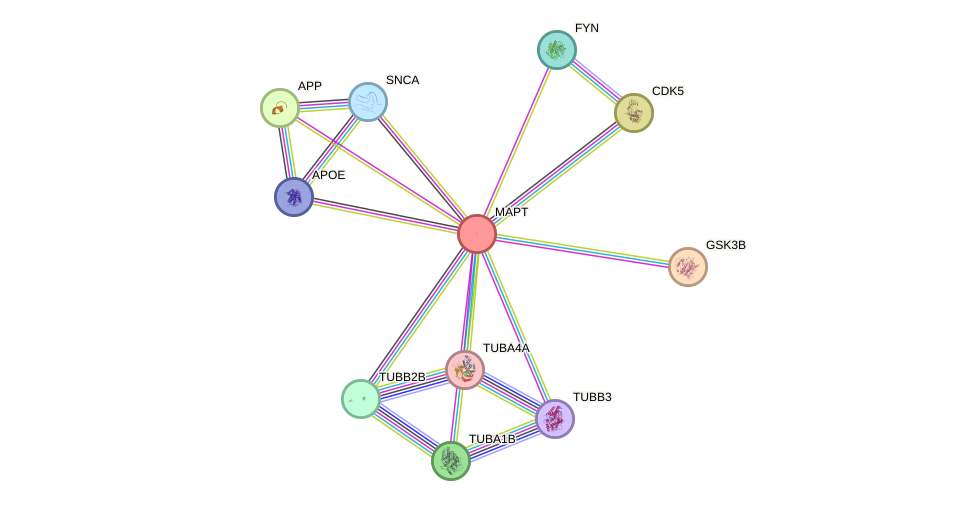GenAge entry for MAPT (Homo sapiens)
Gene name (HAGRID: 205)
- HGNC symbol
- MAPT
- Aliases
- MTBT1; tau; PPND; FTDP-17; TAU; MSTD; MTBT2; FLJ31424; MGC138549; PPP1R103; DDPAC; MAPTL
- Common name
- microtubule-associated protein tau
Potential relevance to the human ageing process
- Main reason for selection
- Entry selected based on indirect or inconclusive evidence linking the gene product to ageing in humans or in one or more model systems
- Description
The MAPT protein appears to promote microtubule assembly and stability. MAPT undergoes complex alternative splicing and its transcripts are differentially expressed in the nervous system depending on neuron type and maturation. Abundant evidence exists linking mutations in MAPT to neurodegenerative diseases in humans [1429].
Cytogenetic information
- Cytogenetic band
- 17q21.1
- Location
- 45,894,382 bp to 46,028,333 bp
- Orientation
- Plus strand
Protein information
- Gene Ontology
-
Process: GO:0000226; microtubule cytoskeleton organization
GO:0001774; microglial cell activation
GO:0006919; activation of cysteine-type endopeptidase activity involved in apoptotic process
GO:0007165; signal transduction
GO:0007613; memory
GO:0010506; regulation of autophagy
GO:0010917; negative regulation of mitochondrial membrane potential
GO:0019896; axonal transport of mitochondrion
GO:0031113; regulation of microtubule polymerization
GO:0031116; positive regulation of microtubule polymerization
GO:0031122; cytoplasmic microtubule organization
GO:0031175; neuron projection development
GO:0032930; positive regulation of superoxide anion generation
GO:0033673; negative regulation of kinase activity
GO:0034605; cellular response to heat
GO:0045773; positive regulation of axon extension
GO:0048143; astrocyte activation
GO:0048312; intracellular distribution of mitochondria
GO:0048699; generation of neurons
GO:0050808; synapse organization
GO:0050848; regulation of calcium-mediated signaling
GO:0051259; protein oligomerization
GO:0072386; plus-end-directed organelle transport along microtubule
GO:0090140; regulation of mitochondrial fission
GO:0090258; negative regulation of mitochondrial fission
GO:0098930; axonal transport
GO:1900034; regulation of cellular response to heat
GO:1901216; positive regulation of neuron death
GO:1902474; positive regulation of protein localization to synapse
GO:1902988; neurofibrillary tangle assembly
GO:1903748; negative regulation of establishment of protein localization to mitochondrion
GO:1905689; positive regulation of diacylglycerol kinase activity
GO:2001020; regulation of response to DNA damage stimulus
Cellular component: GO:0005634; nucleus
GO:0005829; cytosol
GO:0005874; microtubule
GO:0005886; plasma membrane
GO:0016020; membrane
GO:0030424; axon
GO:0030425; dendrite
GO:0030426; growth cone
GO:0034399; nuclear periphery
GO:0036464; cytoplasmic ribonucleoprotein granule
GO:0036477; somatodendritic compartment
GO:0043025; neuronal cell body
GO:0044297; cell body
GO:0045298; tubulin complex
GO:0097418; neurofibrillary tangle
GO:1904115; axon cytoplasm
Hide GO termsFunction: GO:0003677; DNA binding
GO:0003779; actin binding
GO:0005515; protein binding
GO:0008017; microtubule binding
GO:0017124; SH3 domain binding
GO:0019899; enzyme binding
GO:0034185; apolipoprotein binding
GO:0034452; dynactin binding
GO:0048018; receptor agonist activity
GO:0051721; protein phosphatase 2A binding
GO:0051879; Hsp90 protein binding
GO:0071813; lipoprotein particle binding
Protein interactions and network
- Protein-protein interacting partners in GenAge
- AKT1, EGFR, PIN1, S100B, ABL1, EP300, GSK3B, APP, APOE, SIRT1, HSPA1A, MAPK8, YWHAZ, PTK2B, HSPA8, MAPT, PSEN1, STUB1, GSK3A, SQSTM1
- STRING interaction network
Retrieve sequences for MAPT
Homologs in model organisms
- Caenorhabditis elegans
- ptl-1
- Danio rerio
- uncharacterized_E7F9
- Mus musculus
- Mapt
- Rattus norvegicus
- Mapt

